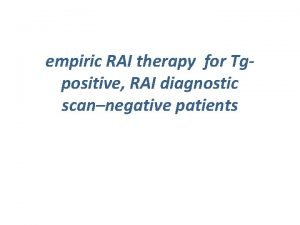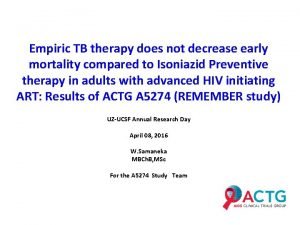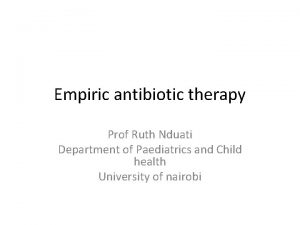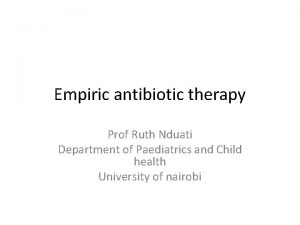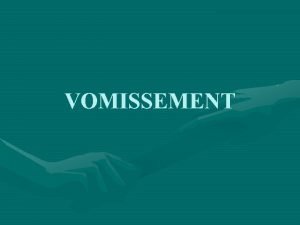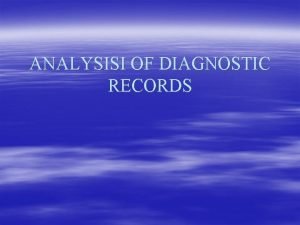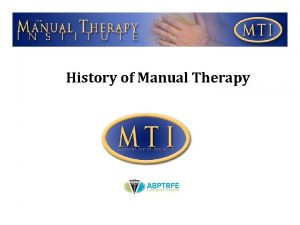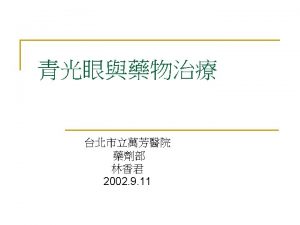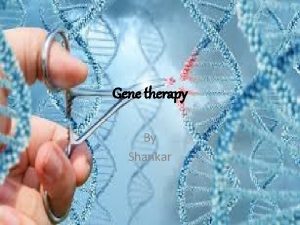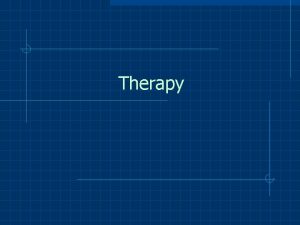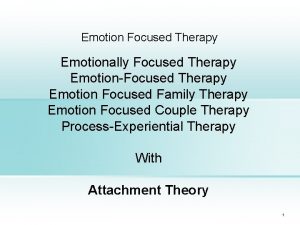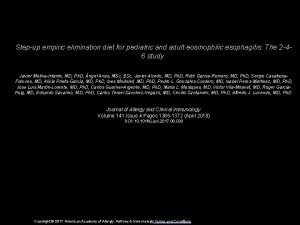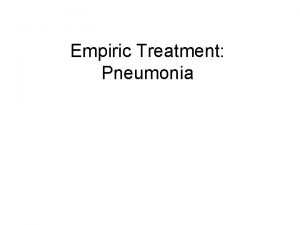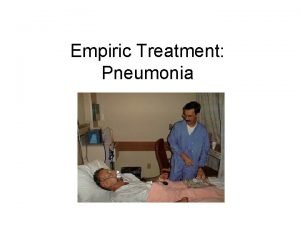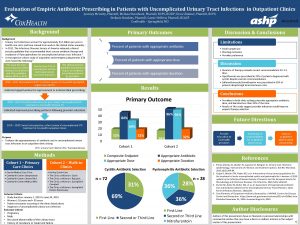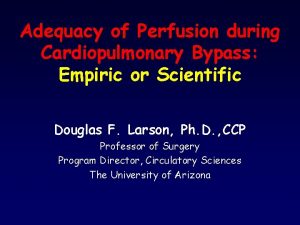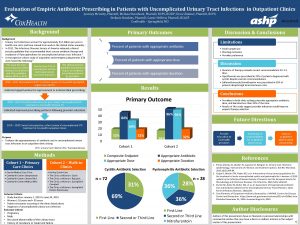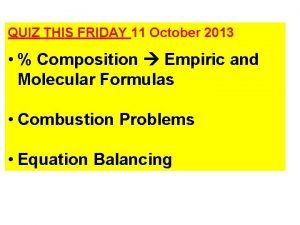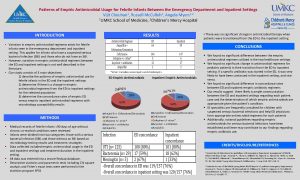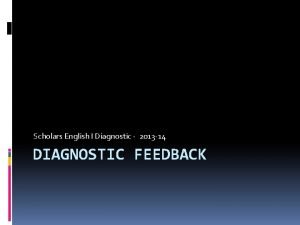empiric RAI therapy for Tgpositive RAI diagnostic scannegative

















































- Slides: 49

empiric RAI therapy for Tgpositive, RAI diagnostic scan–negative patients



When should empiric RAI therapy be considered for Tg-positive, RAI diagnostic scan–negative patients?

RECOMMENDATION In the absence of structurally evident disease, patients with stimulated serum Tg <10 ng/m. L with thyroid hormone withdrawal or <5 ng/m. L with rh. TSH (indeterminate response) can be followed without empric RAI therapy on with continued thyroid hormone therapy alone, reserving additional therapies for those with rising serum Tg levels over time or other evidence of structural disease progression. (Weak recommendation, Low-quality evidence)

RECOMMENDATION Empiric (100– 200 m. Ci) or dosimetricallydetermined radioactive iodine therapy may be considered in patients with: 1 - more significantly elevated serum Tg levels 2 -rapidly rising serum Tg levels or rising Tg antibody levels in whom imaging (anatomic neck/chest imaging and/or 18 FDG-PET/CT) has failed to reveal a tumor source that is amenableto directed therapy.

Con… The risk of high cumulative administered activities of RAI must be balanced against uncertain long-term benefits. If empiric RAI therapy is given and the posttherapy scan is negative, the patient should be considered to have RAI-refractory disease and no further RAI therapy should be administered. (Weak recommendation, Low-quality evidence)

RECOMMENDATION If persistent nonresectable disease is localized after an empiric dose of RAI, and there is objective evidence of significant tumor reduction, then consideration can be made for RAI therapy to be repeated until the tumor has been eradicated or the tumor no longer responds to treatment. The risk of repeated therapeutic doses of RAI must be balanced against uncertain long-term benefits. (Weak recommendation, Low-quality evidence)

Factors to consider when selecting patients for empiric RAI therapy include : level of serum Tg elevation results of 18 FDG-PET scanning Since tumors that are 18 FDG-PET positive generally do not concentrate RAI, RAI therapy is much less likely to be efficacious and RAI therapy is unlikely to alter the poorer outcome in such patients. it is reasonable to perform 18 FDG-PET/CT scanning prior to consideration of empiric RAI therapy.

The cutoff value of serum Tg above which a patient should be treated with an empiric dose of RAI is not clear. Most studies have reported primarily on patients with Tg levels after T 4 withdrawal of 10 ng/m. L or higher; it has been suggested that a corresponding level after rh. TSH stimulation would be 5 ng/m. L. Patients with a suppressed or stimulated serum Tg of 5 ng/m. L or higher are unlikely to demonstrate a decline without therapy, and have higher rates of subsequent structural recurrence than those with lower serum Tg levels. rising serum Tg indicates disease that is likely to become clinically apparent, particularly if it is rapidly rising

If serum Tg levels suggest residual or recurrent disease, but diagnostic RAI WBS imaging is negative and structural imaging does not reveal disease empiric therapy with RAI (100– 200 m. Ci) or dosimetrically-determined RAI activities can be considered for two purposes: 1) to aid in disease localization, and/or 2) as therapy for nonsurgical disease This approach may identify the location of persistent disease in approximately 50% of patients

From a therapeutic perspective, over half of patients experience a fall in serum Tg after empiric RAI therapy in patients with negative diagnostic WBS there is no evidence for improved survival with empiric therapy in this setting there is evidence that Tg levels may decline without specific therapy in a significant proportion of patients with Tg levels < 10 ng/ml. The most compelling evidence for benefit from empiric RAI therapy is for pulmonary metastases, which are not amenable to surgical management or external beam radiotherapy, and RAI response rates are reasonable

How is radioiodine-refractory DTC defined classified?

RECOMMENDATION Radioiodine-refractory structurally-evident DTC is defined classified in patients with appropriate TSH stimulation and iodine preparation in four basic ways: 1) The malignant/metastatic tissue does not ever concentrate radioiodine (no uptake outside thyroid bed at the first diagnostic or therapeutic WBS), 2) the tumor tissue loses the ability to concentrate radioiodine after previous evidence of RAI-avid disease (in the absence of stable iodine occurs in patients with large and multiple metastases and is due to the eradication by 131 I treatment of differentiated cells able to concentrate radioiodine but not of poorly differentiated cells

3) radioiodine is concentrated in some lesions but not in others this is frequent in patients with multiple large metastases 4) metastatic disease progresses despite significant concentration of radioiodine.

When a patient with DTC is classified as refractory to radioiodine, there is no indication for further radioiodine treatment. (Strong recommendation, Moderate-quality evidence Weak recommendation, Lowquality evidence)

What is the role of systemic therapy (kinase inhibitors, other selective therapies, conventional chemotherapy, bisphonates, denosumab) in treating metastatic DTC?

RECOMMENDATION Kinase Inhibitors A) Kinase inhibitor therapy should be considered in RAIrefractory DTC patients with metastatic, rapidly progressive, symptomatic and/or imminently threatening disease not otherwise amenable to local control using other approaches. Kinase inhibitors that are FDA approved for differentiated thyroid carcinoma, or other available kinase inhibitors, can be considered since the impact of these agents on overall survival and quality of life remains to be defined. (Weak recommendation, Moderate-quality evidence)

B) Patients who are candidates for kinase inhibitor therapy should be thoroughly counseled on the potential risks and benefits of this therapy as well as alternative therapeutic approaches including best supportive care. Appropriate informed consent should be obtained and documented in the medical record prior to initiation of any therapy, regardless of whether the patient is being treated in the context of a clinical trial. (Strong Recommendation, Low-quality evidence)

Kinase inhibitors, many of which share the common target of the VEGF receptor, (e. g. sorafenib, pazopanib, sunitinib, lenvatinib, axitinib, cabozantinib and vandetanib) have recently emerged as highly promising therapies for metastatic RAI-refractory

adverse effects including: diarrhea, fatigue, induced hypertension, hepatotoxicity, skin changes, nausea, increased levothyroxine dosage requirement, changes in taste and weight loss. side effects: negatively impacting quality of life necessitating dosage reductions in nearly two-thirds of treated many patients treatment discontinuation in up to 20% of patients. more serious risks: thrombosis, bleeding, heart failure, hepatotoxicity, GI tract fistula formation and intestinal perforation.

Three randomized placebo-controlled clinical trials (phase 2, vandetanib; phase 3, sorafenib and lenvatinib) had been published by the time of the writing of these guidelines, each demonstrating delayed time to disease progression among kinase inhibitor-treated, relative to placebo-treated, patients.

On this basis, sorafenib and lenvatinib were approved for use in the United States and the European Union for patients with advanced RAIrefractory DTC. Sorafenib or vandetanib treatement were each associated with progression free survival prolonged by 5 months, but with no improvement on overall survival.

Consequently, therapeutic decisions are presently based upon the convergence of “expert opinion” and patient preference/philosophy

when treatment should be discontinued once initiated? In general, therapy should be continued so long as net benefit exceeds net detriment.

Patients who fail first-line kinase inhibitor • therapy

RECOMMENDATION Patients who incur disease progression while on initial kinase inhibitor therapy without prohibitive adverse effects should be considered for second-line kinase inhibitor therapy. Ideally, such therapy should be undertaken within the context of therapeutic clinical trials. (Weak recommendation, Low-quality evidence)

Other Novel Agents RECOMMENDATION Agents without established efficacy in DTC should be used only primarily within the context of therapeutic clinical trials. (Strong recommendation, Low-quality evidence)

Include: BRAF kinase inhibitors, as these agents have already shown efficacy and been approved for use in BRAF mutant melanoma Inhibitors of MEK kinase and other signaling pathways Use within the context of therapeutic clinical trials, or alternatively when used as “salvage” therapies after disease progression has occurred despite prior VEGFR-directed kinase inhibitor therapy.

Cytotoxic Chemotherapy RECOMMENDATION Cytotoxic chemotherapy can be considered in RAIrefractory DTC patients with metastatic, rapidly progressive, symptomatic, and/or imminently threatening disease not otherwise amenable to control through other approaches including kinase inhibitors. Too few data exist to recommend specific cytotoxic regimens, and use within the context of a therapeutic clinical trial is preferred. (Weak recommendation, Low-quality evidence)

Bone-Directed Agents RECOMMENDATION Bisphonate or denosumab therapy should be considered in patients with diffuse and/or symptomatic bone metastases from RAIrefractory DTC, either alone or concomitantly with other systemic therapies. (Strong recommendation, Moderate-quality evidence)


SERUM TG Tg is a big glycoprotein It is almost exclusively produced by thyroid follicular cells, although some evidence suggests that small amounts of Tg can also be produced by the thymus gland

Increasing of Already Detectable Serum Tg: Persistent Disease The presence of detectable levels of serum Tg in the absence of any detectable lesions using common imaging techniques is defined as biochemical disease. Despite industrious attempts to find the source of Tg production, all imaging procedures produce negative results in approximately 10% of patients with detectable levels of either basal or stimulated Tg.

Possible ectopic Tg production from residual thymus should be considered in the presence of persistent relatively low detectable levels of serum Tg, especially in young patients. This hypothesis can be supported by a computed tomography (CT) scan of the neck/mediastinum region and the presence of an enlarged thymus. This technique does not prove thymus is the source of Tg, but raises the suspicion.

In patients with detectable levels of serum Tg, a stable value of serum Tg is considered a favorable finding and indicative of stable disease. The same concept is valid for both patients with biochemical disease and metastatic disease. Given these comments, no active or aggressive therapies should be prescribed; rather, a “wait and see” strategy should be applied to most of these patients, who must be monitored closely


Unfortunately, the quantitative interval Tg increase that should promote further investigation is currently unknown serum Tg doubling time less than 1 year, when patients are on LT 4 therapy, represents a poor prognostic factor for their cancer-related survival.


Anatomic Imaging in Thyroid Cancer Ultrasound diagnostic accuracy for thyroid lesions is as high as 85% CT sensitivity of 80– 90. 6% for detecting cervical metastases, although it may fail to detect diffuse interstitial lung metastases that may be visualized on radioiodine scintigraphy MRI gadolinium- based contrast agents can be used without interfering with radioiodine administration/ excellent tissue contrast and lack of radiation exposure/characterizing the invasion of trachea and adjacent organs for surgical planning.

FDG PET/CT in Differentiated Thyroid Carcinoma Whole-body scan (WBS) with radioiodine (131 I) is the most effective method for tumor detection, staging, and treatment planning Iodine-131 -WBS is useful for: determining the differentiation of the tumor on the basis of its avidity to iodine remnant thyroid tissue distant metastatic disease

most well-differentiated thyroid carcinomas are relatively slow growing and can be FDG negative FDG PET has a high sensitivity (up to 85%) and specificity (up to 95%) for distant metastases in patients with DTC.

The combination of 131 IWBS and thyroglobulin measurement is a reliable indicator of the presence of metastases in 82. 6% of patients with DTC after surgery. FDG PET/CT plays a valuable role in the postthyroidectomy workup of patients with DTC who have elevated thyroglobulin levels and a negative 131 I-WBS

Review of a total of 25 studies comprising of 789 patients: FDG PET/CT has a high pooled sensitivity of 93. 5% for detecting DTC recurrence and metastasis in the absence of radioiodine uptake. similar meta-analysis of 12 studies and literature review: PET/CT had a sensitivity of 94. 0% for detecting recurrence of PTC.

Several studies : definite correlation between the thyroglobulin levels and the diagnostic accuracy of PET. higher diagnostic accuracy of PET/CT with high thyroglobulin levels.


The impact of thyroid-stimulating hormone (TSH) levels on radioiodine scans has been established however, regarding the impact of TSH levels on improving accuracy of FDG PET/ CT, no complete consensus exists.

Vural et al. have observed higher PET positivity in patients older than 40 years compared with younger patients (70% vs 53%).

Thank you for your attention
 Empiric era of pharmacy
Empiric era of pharmacy Apa yang dimaksud peluang teoritik
Apa yang dimaksud peluang teoritik Evolution of pharmacy
Evolution of pharmacy Rai diagnostic
Rai diagnostic Bioness integrated therapy system occupational therapy
Bioness integrated therapy system occupational therapy What are the major humanistic therapies
What are the major humanistic therapies Psychoanalytic vs humanistic
Psychoanalytic vs humanistic Verksamhetsanalys exempel
Verksamhetsanalys exempel Novell typiska drag
Novell typiska drag Tack för att ni har lyssnat
Tack för att ni har lyssnat Centrum för kunskap och säkerhet
Centrum för kunskap och säkerhet Läkarutlåtande för livränta
Läkarutlåtande för livränta Klassificeringsstruktur för kommunala verksamheter
Klassificeringsstruktur för kommunala verksamheter Inköpsprocessen steg för steg
Inköpsprocessen steg för steg Påbyggnader för flakfordon
Påbyggnader för flakfordon Egg för emanuel
Egg för emanuel En lathund för arbete med kontinuitetshantering
En lathund för arbete med kontinuitetshantering Anatomi organ reproduksi
Anatomi organ reproduksi Formel för standardavvikelse
Formel för standardavvikelse Tack för att ni har lyssnat
Tack för att ni har lyssnat Rutin för avvikelsehantering
Rutin för avvikelsehantering Mitos steg
Mitos steg Presentera för publik crossboss
Presentera för publik crossboss Myndigheten för delaktighet
Myndigheten för delaktighet Tack för att ni lyssnade
Tack för att ni lyssnade Att skriva debattartikel
Att skriva debattartikel Var 1721 för stormaktssverige
Var 1721 för stormaktssverige Tobinskatten för och nackdelar
Tobinskatten för och nackdelar Tack för att ni lyssnade bild
Tack för att ni lyssnade bild Hur ser ett referat ut
Hur ser ett referat ut Byggprocessen steg för steg
Byggprocessen steg för steg Tät skog karttecken
Tät skog karttecken Rådet för byggkompetens
Rådet för byggkompetens Tryck formel
Tryck formel Elektronik för barn
Elektronik för barn Adressändring ideell förening
Adressändring ideell förening Densitet vatten
Densitet vatten Tack för att ni har lyssnat
Tack för att ni har lyssnat Borra hål för knoppar
Borra hål för knoppar Smärtskolan kunskap för livet
Smärtskolan kunskap för livet Frgar
Frgar Vad är ett minoritetsspråk
Vad är ett minoritetsspråk Mjälthilus
Mjälthilus Tallinjen
Tallinjen För och nackdelar med firo
För och nackdelar med firo Indikation för kejsarsnitt på moderns önskan
Indikation för kejsarsnitt på moderns önskan Ekologiskt fotavtryck
Ekologiskt fotavtryck Blomman för dagen drog
Blomman för dagen drog Redogör för vad psykologi är
Redogör för vad psykologi är Bris för vuxna
Bris för vuxna



